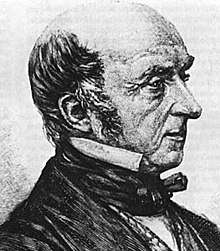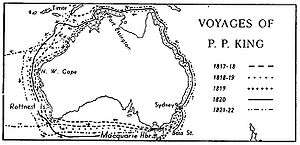Phillip Parker King
Admiral Phillip Parker King, FRS, RN (13 December 1791 – 26 February 1856) was an early explorer of the Australian and Patagonian coasts.[1]
Phillip Parker King | |
|---|---|
 Phillip Parker King | |
| Born | Phillip Parker King 13 December 1791 Norfolk Island, New South Wales, Australia |
| Died | 26 February 1856 (aged 64) North Sydney, New South Wales, Australia |
| Occupation | Naval Officer |
| Known for | Exploration of the coastline of Australia |
| Title | Admiral |
Early life and education
King was born on Norfolk Island, to Philip Gidley King and Anna Josepha King née Coombe, and named after his father's mentor, Admiral Arthur Phillip (1738–1814), (first governor of New South Wales and founder of the British penal colony which later became the city of Sydney in Australia), which explains the difference in spelling of his and his father's first names. King was sent to England for education in 1796, and he joined the Royal Naval Academy, at Portsmouth, in county Hampshire, England in 1802. King entered the Royal Navy in 1807, where he was commissioned lieutenant in 1814.
Expeditions in Australia
King was assigned to survey the parts of the Australian coast not already examined by Royal Navy officer, Matthew Flinders, (who had already made three earlier exploratory voyages between 1791 and 1810, including the first circumnavigation of Australia) and made four voyages between December 1817 and April 1822. Amongst the 19-man crew were Allan Cunningham (botanist), John Septimus Roe and the aborigine Bungaree.[2] The first three trips were in the 76 tonne cutter HMS Mermaid, but the vessel was grounded in 1829.
The Admiralty instructed King to discover whether there was any river 'likely to lead to an interior navigation into this great continent'. The Colonial Office had given instructions to collect information about topography, fauna, timber, minerals, climate, and the natives and the prospects of developing trade with them. From February to June 1818, the coast was surveyed as far as Van Diemen Gulf and there were many meetings with Aboriginals and Malay proas. In June the Mermaid visited Timor and then returned to Sydney, arriving on 29 July. Next December and January King surveyed Macquarie Harbour in Van Diemen's Land and sailed in May 1819 for Torres Strait. King took John Oxley as far as the Hastings River, and continued on to survey the coast between Cape Wessel and Admiralty Gulf. King returned to Sydney on 12 January 1820.

King's fourth voyage was undertaken in the 154 tonne sloop HMS Bathurst. The ship headed north, through Torres Strait and to the north-west coast of the continent, including the Dampier Archipelago. Further survey of the west coast was made after a visit to Mauritius. Valuable contributions had been made to the exploration of Australia.
Expeditions to South America
King had been promoted to commander in July 1821, and in April 1823 returned to England. He subsequently commanded the survey vessel HMS Adventure, and in company with HMS Beagle, spent five years surveying the complex convoluted coasts around the Strait of Magellan (1826–1830) at the southern tip of South America. At the same time, King put together a unique collection of Patagonian objects from local tribes living in Tierra del Fuego, which was later donated to the British Museum in London.[3][4][5] In addition to written records, King also lent his hand to drawing and watercolour painting for illustrations,[6] some of which were later used to illustrate his accounts.[7] The result was presented at a meeting of the Royal Geographical Society in 1831. His eldest son, also named Philip Gidley King,[8] accompanied his father and continued as a midshipman on HMS Beagle (1832–1836) on the continuing survey of Patagonia under Robert FitzRoy, in the company of noted scientist Charles Darwin (1809–1882). King owned a property at Dunheved in the western suburbs of Sydney where he entertained Charles Darwin on Darwin's last night in Sydney in January 1836.
Later life

King was appointed to the first New South Wales Legislative Council in 1829, however he was absent from the colony and did not take his seat and was replaced by John Campbell.[9] When King returned to the colony in 1832 he pressed for his reappointment to the Council, however he was not re-appointed until February 1839.[1] In April the same year King was appointed resident commissioner of the Australian Agricultural Company, a position he held for ten years. King offered to resign from the Council on accepting this appointment, but his resignation was not accepted until October.[1][10] King was again appointed to the Legislative Council in 1850, and was elected as the member for the Counties of Gloucester and Macquarie in 1851
In 1855 King was promoted to Rear admiral on the retired list. King was a Fellow of the Royal Society.[1]
Family
King married Harriet Lethbridge in 1817 prior to sailing to New South Wales. Harriet died at Ashfield, Sydney, on 19 December 1874.[1] Together they had eight children including :
- Philip Gidley (1817–1904) stock manager of the Australian Agricultural Co & later a member of the Legislative Council.[12]
- John (1820–1895)[13]
- (William) Essington (1821–1910)[13]
- Rev. Robert Lethbridge (1823–1897) was principal of Moore Theological College in 1868–78.[14]
- (Charles) Macarthur (1824–1903)[15]
- Frederick (1825–1895),[16]
- Arthur Septimus (1827–1899)[13]
Legacy
King was honoured on the 2-pound postage stamp of Australia in 1963.
The Australian native orchid Dendrobium kingianum has been named after him.
King Sound in the Kimberley region of Western Australia was also named after King who explored the region in 1818.
Six species of reptiles are named in his honour: Amphisbaena kingii, Chlamydosaurus kingii, Egernia kingii, Elgaria kingii, Hydrophis kingii, and Liolaemus kingii.[17]
Works
- King, Phillip Parker (1827), Narrative of a Survey of the intertropical and western Coasts of Australia : performed between the years 1818 and 1822, London: John Murray
- Extracts from a letter addressed by Capt. Philip Parker King, R.N., F.R.S. and L.S., to N.A. Vigors, Esq., on the animals of the Straits of Magellan. Zoological Journal London 3:422-32. 1828.
- Notes on birds collected by Capt. King in Chile.Proceedings of the Committee of Science and Correspondence of the Zoological Society of London, 1831: 29–30.1831
- King, Phillip Parker (1832), Sailing Directions to the Coasts of Eastern and Western Patagonia, and the Straits of Magellan and the Sea-Coast of Tierra del Fuego, London: Hydrographical Office, Admiralty
- King, P.P. and Broderip, W.J. Description of Cirrhipedia, Conchifera and Mollusca, in a collection formed by the officers of H.M.S. Adventure and Beagle employed between the years 1826 and 1830 in surveying the southern coasts of South America, including the Straits of Magalhaens and the coast of Tierra del Fuego. The Zoological Journal, 5: 332–349.1832
- King, P. P. (1839), FitzRoy, Robert (ed.), Narrative of the surveying voyages of His Majesty's Ships Adventure and Beagle between the years 1826 and 1836, describing their examination of the southern shores of South America, and the Beagle's circumnavigation of the globe. Proceedings of the first expedition, 1826–30, under the command of Captain P. Parker King, R.N., F.R.S., I, London: Henry Colburn.
See also
- King expedition of 1817
- European and American voyages of scientific exploration
Notes
- "King, Phillip Parker (1791–1856)". Australian Dictionary of Biography. 2. Melbourne University Press. 1967. ISSN 1833-7538. Retrieved 21 November 2014 – via National Centre of Biography, Australian National University.
- Indigenous intermediaries: new perspectives on exploration archives. Konishi, Shino, Nugent, Maria, Shellam, Tiffany. Acton, A.C.T.: ANU Press. 2015. p. 88. ISBN 9781925022773. OCLC 917505639.CS1 maint: others (link)
- British Museum Collection
- British Museum Collection
- British Museum Collection
- "Drawing: [untitled] watercolour: drawings: Montevideo; and [untitled] (watercolour)". cudl.lib.cam.ac.uk. Cambridge Digital Library. Retrieved 24 November 2014.
- "Phillip Parker King (1791–1856)". australianmuseum.net.au. Australian Museum. Retrieved 24 November 2014.
- O'Grady, Frank (1974). "King, Philip Gidley (1817–1904)". Australian Dictionary of Biography. 5. Melbourne University Press. ISSN 1833-7538. Retrieved 21 November 2014 – via National Centre of Biography, Australian National University.
- "The new Council warrant has arrived". The Australian. 17 July 1829. p. 2. Retrieved 19 April 2019 – via National Library of Australia.
- "Captain Phillip Parker King, RN (1791–1856)". Former Members of the Parliament of New South Wales. Retrieved 18 April 2019.
- "Memoir of Rear-Admiral Philip Parker King, FRS, FRAS, FLS". The Sydney Morning Herald. 28 February 1856. p. 5. Retrieved 19 April 2019 – via National Library of Australia.
- O'Grady, Frank (1974). "King, Philip Gidley (1817–1904)". Australian Dictionary of Biography. Melbourne University Press. ISSN 1833-7538. Retrieved 19 April 2019 – via National Centre of Biography, Australian National University.
- Rogers, Dorothy A (1974). "King, John (1820–1895), William Essington (1821–1910) & Arthur Septimus (1827–1899)". Australian Dictionary of Biography. Melbourne University Press. ISSN 1833-7538. Retrieved 19 April 2019 – via National Centre of Biography, Australian National University.
- Cable, K J. "King, Robert Lethbridge (1823–1897)". Australian Dictionary of Biography. Melbourne University Press. ISSN 1833-7538. Retrieved 19 April 2019 – via National Centre of Biography, Australian National University.
- "King, Charles Macarthur (1824–1903)". Obituaries Australia. Australian National University. Retrieved 19 April 2019.
"The late Mr C Macarthur King". The Sydney Morning Herald. 7 September 1903. p. 6. Retrieved 19 April 2019 – via National Library of Australia. - "Family Notices: deaths". The Sydney Morning Herald. 19 July 1895. p. 1. Retrieved 19 April 2019 – via National Library of Australia.
- Beolens, Bo; Watkins, Michael; Grayson, Michael (2011). The Eponym Dictionary of Reptiles. Baltimore: Johns Hopkins University Press. xiii + 296 pp. ISBN 978-1-4214-0135-5. ("King, P.P.", p. 141).
References
- Kemp, Peter (1976). The Oxford Companion to Ships and the Sea. Oxford. p. 450. ISBN 9780192115539.
- Thompson, R. T., 1998 Insect collections made by Captain P.P. King in South America 1826–1830, with a list of some of the beetles Archives of Natural History 25: 331–343
External links
| Wikimedia Commons has media related to Phillip Parker King. |
- King's journals online
- NSW state papers holdings for Phillip Parker King
- NRA records for King
- Works by Phillip Parker King at Project Gutenberg
- Works by or about Phillip Parker King at Internet Archive
- Godley, E. J., Biographical Notes: Phillip Parker King (1791–1856)
- Phillip Parker King: The great hydrographer of the Magellanic sea. (Spanish). By Mateo Martinic
- Inauguration of Phillip Parker King's memorial in San Juan de la Posesión Bay (Chile)
- Monument to Captain Philip Parker King R.N.: San Juan de la Posesión Bay, Magellan Strait, (Chile)
- The Allan Cunningham Project Allan Cunningham was the botanist on HMS Mermaid and HMS Bathurst with Phillip Parker King
- The Tomb of Phillip Parker King an article from The Allan Cunningham Project
- Chart of the intertropical and west coasts of Australia: as surveyed in the years 1820 to 1822 by Phillip P. King, R. N. J. Walker sculpt. Published London: John Murray; 1825.
- O'Byrne, William Richard (1849). . . John Murray – via Wikisource.
| New South Wales Legislative Council | ||
|---|---|---|
| New title Counties of Gloucester, Macquarie, and Stanley divided into 3 |
Member for Counties of Gloucester & Macquarie 1851 – 1856 |
Council replaced by new parliament |